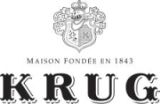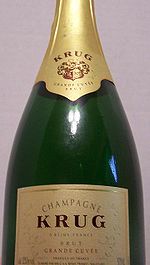
Champagne Krug
Encyclopedia

Négociant
A négociant is the French term for a wine merchant who assembles the produce of smaller growers and winemakers and sells the result under its own name....
-manipulateur" with offices in Reims
Reims
Reims , a city in the Champagne-Ardenne region of France, lies east-northeast of Paris. Founded by the Gauls, it became a major city during the period of the Roman Empire....
, the main city in Champagne—was one of the famous Champagne houses who formed part of the membership of the Grande Marques. Krug Grande Cuvée is one of the crown jewels in the LVMH
LVMH
LVMH Moët Hennessy • Louis Vuitton S.A., better known as LVMH, is a French multinational luxury goods conglomerate headquartered in Paris, Île-de-France, France. The company was formed after the 1987 merger of fashion house Louis Vuitton with Moët Hennessy, a company formed after the 1971 merger...
wine division, placed alongside the Moët et Chandon
Moët et Chandon
Moët & Chandon , or Moët, is a French winery and co-owner of the luxury goods company Moët-Hennessy • Louis Vuitton. Moët et Chandon is one of the world's largest champagne producers and a prominent champagne house. The company holds a Royal Warrant to supply champagne to Elizabeth II...
's Cuvée Dom Pérignon
Dom Pérignon (wine)
Dom Pérignon is a brand of vintage Champagne produced by the Champagne house Moët & Chandon and serves as that house's prestige champagne. It is named after Dom Pérignon, a Benedictine monk who was an important quality pioneer for Champagne wine but who, contrary to popular myths, did not discover...
and Veuve Clicquot
Veuve Clicquot
Veuve Clicquot Ponsardin is both a champagne house in Reims, France, and a brand of premium champagne. Founded in 1772 by Philippe Clicquot-Muiron, Veuve Clicquot played an important role in establishing champagne as a favored drink of haute bourgeoisie and nobility throughout Europe...
's La Grande Dame. As a Champagne, it is distinctive and easily recognised by taste due to the house's policy of complete barrel fermentation and very extended lees aging; on the nose, Krug is identified by its strongly developed and aged nutty lees influence and autolytic
Autolysis (wine)
Autolysis in winemaking relates to the complex chemical reactions that take place when a wine spends time in contact with the lees, or dead yeast cells, after fermentation. While for some wines autolysis is undesirable, it is a vital component in shaping the flavors and mouth feel associated with...
notes, a certain oakiness, as well as a combination of disgorgement freshness and oxidative maturity. On the palate, Krug wines commonly display a raciness resulting from suppression of the malolactic fermentation, and a richness both from lees and from barrel fermentation. It is one of the most obviously oaky of Champagnes and is almost invariably dry (less than 10 g/l residual sugar).
History of the House
Krug was established in 1843 by Johann-Joseph Krug, a German immigrant from MainzMainz
Mainz under the Holy Roman Empire, and previously was a Roman fort city which commanded the west bank of the Rhine and formed part of the northernmost frontier of the Roman Empire...
on the Rhine. In relative terms, this makes it a middle-aged to young house, compared to the old houses in Champagne, several of which have been going for more than ten generations. Johann learned his trade at Champagne Jacquesson for nine years before setting up Krug at Reims. His son, Paul continued the family business, who was succeeded by his son, Joseph Krug II in 1910. Joseph's nephew, Jean Seydoux, took the reins in 1924. Jean Sedoux, together with Paul Krug II are generally credited with creating the Krug style with the now defunct Private Cuvée. In 1962, Henri Krug took over the house, and he is still largely responsible for the winemaking decisions here, along with Eric Lebel. The house is now part of global luxury brands conglomerate Louis Vuitton Moët Hennessy (LVMH). Like most of the companies in the group, Krug runs with a certain amount of autonomy. This perceived and real autonomy has played a large role in maintaining the house's reputation and consistent style.
Vineyards
The house owns 20 hectares of vines in AÿAy, Marne
Ay is a commune in the Marne department in north-eastern France.-Champagne:...
, Le Mesnil
Le Mesnil
Deriving from Latin 'mansionile', meaning a small 'mansio', or dwelling, Le Mesnil may refer to:-Belgium:* Le Mesnil, Belgium, a commune in the municipality of Viroinval in the Namur province-France:...
, and Trépail. They get the rest of their grapes from long-term contract growers. Unlike other négociants, Krug's growers consider themselves part of a long-standing prestigious group that openly reveal Krug as the destination of their grapes.
Aÿ supplies the Pinot Noir which goes into the non-vintage Rose, and Le Mesnil produces the Chardonnay which makes up the Clos du Mesnil Blanc de Blancs vintage. Krug owns a relatively small proportion of vineyard.
Oenology
All the wines at Krug undergo primary fermentation in small 205 litre oak barrels from the Forest of ArgonneForest of Argonne
The Forest of Argonne is a long strip of rocky mountain and wild woodland in north-eastern France.In 1792 Charles François Dumouriez outmaneuvered the invading forces of the Duke of Brunswick in the forest before the Battle of Valmy....
and Central France. The barrels are all well-seasoned and organoleptically inert. Each cru is vinified separately, with no malolactic fermentation, and the two rackings are done by gravity. Reserve wines are transferred to stainless-steel tanks.
The house's standard release, the Grande Cuvée NV is blended from anywhere between 20 and 30 crus across Champagne, with almost all being rated 100%, or Grand Cru. The reserve wines hail from 6 to 10 vintages, and not necessarily the most recent vintages, and usually including a fair proportion of declarable vintages which the company insists explains the high quality of their wine. Krug disgorges its wines no earlier than six years on lees, with the Collection series being held on lees for as long as 15 to 20 years.
Krug utilises all three Champagne varieties in their wines, Chardonnay
Chardonnay
Chardonnay is a green-skinned grape variety used to make white wine. It is originated from the Burgundy wine region of eastern France but is now grown wherever wine is produced, from England to New Zealand...
, Pinot Noir
Pinot Noir
Pinot noir is a black wine grape variety of the species Vitis vinifera. The name may also refer to wines created predominantly from Pinot noir grapes...
, and Pinot Meunier
Pinot meunier
Pinot Meunier, , also known as Meunier or Black Riesling, is a variety of black wine grape most noted for being one of the three main grapes used in the production of champagne...
. However, Chardonnay is the mainstay of the Grande Cuvee and their flagship single vineyard vintage, the Clos du Mesnil is made in the Blanc de blancs style, made completely from Chardonnay. In April 2008, Krug released the 1995 Clos d'Ambonnay, its debut of a Blanc de noirs Champagne, made entirely from Pinot Noir from a single 0.685 hectares (1.7 acre) vinyard.
Wines

- Grande Cuvée NV
- Rose NV
- A vintage bottling produced in good to excellent years (e.g. Krug 1988)
- Clos du Mesnil (single vineyard, single vintage, blanc de blancs bottling)
- Clos d'Ambonnay (single vineyard, single vintage, blanc de noir bottling)
- Krug Collection (a recently released older vintage bottling)
Marketing
Krug produces mainly Grande Cuvée, supplemented by a non-vintage rosé, a vintage blanc, and a vintage blanc de blancs from the Clos du Mesnil in the Cotes de Blancs and older vintages released as Krug Collection series. The house uses as its competitive edge the fact that it does not make a non-vintage, rather a multi-vintage. Although technically meaning the same thing, Krug's non-vintage, the Grande Cuvée, is a blend of only good, or declarable vintages. The house also emphasises the fact that primary fermentation occurs completely in small oak barrels; a practice not commonplace anymore in Champagne.Krug is sometimes considered a producer of only prestige cuvées, which is one of the tenets of the company's marketing strategy. They justify this by pointing out the large number of high-rated crus and the choices of vintages, as well as the extended lees ageing regime of their standard wine, the Grande Cuvee as being similar, if not more than most other house's Prestige Cuvees. Certainly the price of Krug wines is much higher than other Champagne, with even the Grande Cuvee being priced higher than other very prestigious and highly regarded Prestige Cuvees such as Taittinger's Comtes de Champagne, Moet's Dom Perignon, Veuve's La Grande Dame, Bollinger's RD etc.
Further reading
- Richard JuhlinRichard JuhlinRichard Juhlin, born 1962, is a Swedish Champagne writer, who has written a number of books that have been translated into several languages, including English and French....
, 4000 Champagnes, Flammarion, 2002 - Hugh JohnsonHugh Johnson (wine writer)Hugh Johnson OBE is a British author and expert on wine. He is considered the world's best-selling wine writer.-Career:Johnson became a member of the Cambridge University Wine and Food Society while an undergraduate at King's College, Cambridge in the 1950s, while reading English...
, Wine Companion, Mitchell Beazley, revised ed. 2003 - Hugh Johnson and Jancis Robinson, The World Atlas of Wine, Mitchell Beazley, 5th Ed. 2001
- Jancis RobinsonJancis RobinsonJancis Mary Robinson OBE, MW is a British wine critic, journalist and editor of wine literature. She currently writes a weekly column for the Financial Times, and writes for her website jancisrobinson.com...
, The Oxford Companion to Wine, Oxford Press, 2nd Ed. 1999 - Tom Stevenson, The New Sotheby's Wine Encyclopedia, Dorling Kindersley, 3rd Ed. 2001

